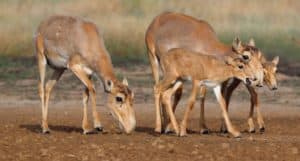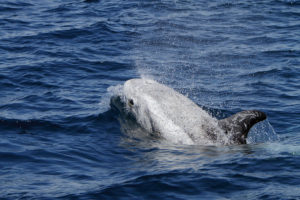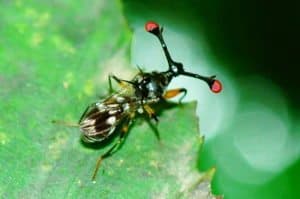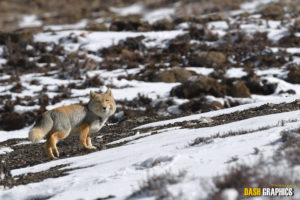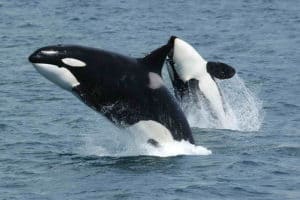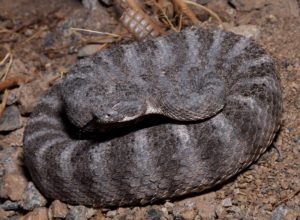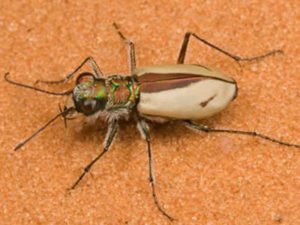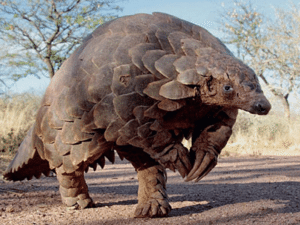Saiga Antelope Facts Related Articles Saiga Antelope Physical Description The most noticeable feature of the Saiga Antelope is its unique proboscis. This represents an over-sized nose structure which serves two purposes. During migrations in the summer, it serves to filter out dust, and during the winter it heats up the frigid air before it enters […]
Risso’s Dolphin
Risso’s Dolphin Facts Related Articles Source: http://bit.ly/2FwzY4x Photo: Mike Baird CCL: http://bit.ly/2xQPH8p Risso’s Dolphin Physical Description Sexual Dimorphism is present among the Risso’s Dolphin, but only to a small extent. The males grow slightly larger, attaining a length of as much as 12.5 ft (3.8 m). These sometimes weigh as much as 1,100 lb (500 […]
Stalk Eyed Fly
Stalk Eyed Fly Facts Stalk Eyed Fly Physical Characteristics The number of known species of Stalk Eyed Fly in the world totals approximately 100. All of these tend to be either small or medium-sized, in relation to other flies. As a result, their sizes range from 0.15-0.45 in (4-12 mm) in length. Their heads develop […]
Tibetan Sand Fox
Tibetan Sand Fox Facts Related Articles Tibetan Sand Fox Physical Description The impressive Tibetan Sand Fox rarely fails to capture the attention and fascination of those fortunate enough to encounter one. Yet, the mammal typically does so due more to its appearance than sheer size. In terms of that trait, it represents an approximately medium-sized […]
Orca
Orca Facts Related Articles Source: http://bit.ly/2DrVNQD Photo: Maarten Visser CCL: http://bit.ly/2RcCTlc Orca Physical Description Perhaps most notably, the adult Orca possesses a very distinctive color pattern. and is therefore rarely confused with any other creature, even at a distance. Typically, the animal presents black on the back with sides and chest a bright white in […]
Tiger Rattlesnake
Tiger Rattlesnake Facts Related Articles Source: http://bit.ly/2AShJ6p Photo: Ltshears CCL: http://bit.ly/2IjEG4n Tiger Rattlesnake Physical Description The Tiger Rattlesnake classifies as a type of pit viper. It also qualifies as a smaller than average one. Like many species of reptiles, though, it displays the trait of sexual dimorphism. In its case, the males typically attain a […]
Coral Pink Sand Dune Beetle
Coral Pink Sand Dune Beetle Facts Related Articles Coral Pink Sand Dune Beetle Physical Description Much as with many insects, the Coral Pink Sand Dune Beetle displays the principle of sexual dimorphism. In its case, females usually reach a larger size than males. Both genders remain tiny. That’s because an overall average body length measures […]
Fossa
Source: http://bit.ly/1GxkjO6 Photo: Ran Kirlian CCL: http://bit.ly/2xLZ0ap Fossa Facts Related Articles Source: http://bit.ly/2oy4gew Photo: Chad Teer CCL: http://bit.ly/2xQPH8p Fossa Physical Description The fabulous Fossa represents a truly distinctive creation of Nature and evolutionary processes. Despite its definite feline-like appearance, though, it holds no relationship with cats. It developed similar traits independently, via a process known […]
Pangolin
Pangolin Facts Related Articles Pangolin Physical Description Due to its rather distinctive appearance, the Pangolin remains easily recognizable. In recent times, it has even become something of a media sensation. This occurs due to the coincidental evolution of a unique visage. Additionally, the scales covering its body grow large in relation to body size. Furthermore, […]
Black Footed Cat
Source: http://bit.ly/2DOxeyI Photo: Charles Barilleaux CCL: http://bit.ly/2xQPH8p Black Footed Cat Facts Related Articles Black Footed Cat Physical Description Firstly, the common name Black Footed Cat actually remains somewhat deceptive. That’s because, in spite of the descriptive name, only the bottom of the feet appear fully black in color. Yet, the name seems to fit. The species […]
